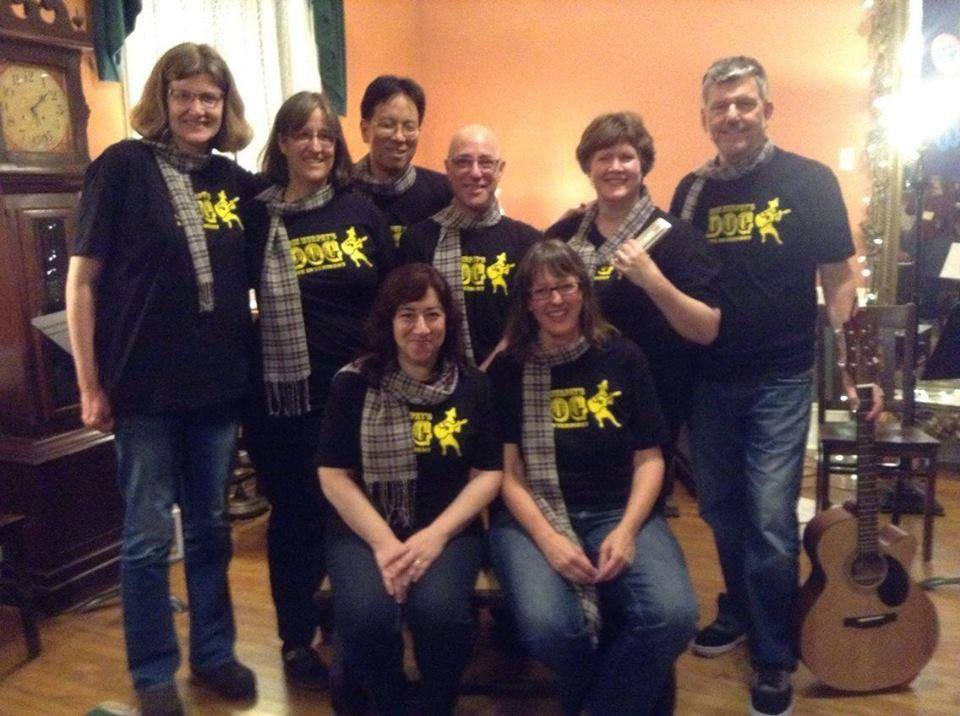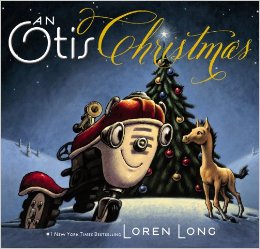
The thing about established picture book series and holiday books is that there just doesn’t seem to be a stopping point. I mean at least with alcohol, the bartender might cut you off or a friend might say something. Sure, you think it’s just going to be one, one Christmas book and that’s it. No harm there. But then you don’t want to seem to be slighting Hanukkah, and there’s Easter to consider since you already have minor rabbit characters, and St. Patrick’s Day — nobody’s really tackled the snake-banishing element. The next thing you know, you’re binging on holidays and seasons and soon enough you are not even pretending to have any standards, you’re franchised.
Continue reading
Welcome to the Newest ShelfTalker Blogger!
Elizabeth Bluemle - June 17, 2014
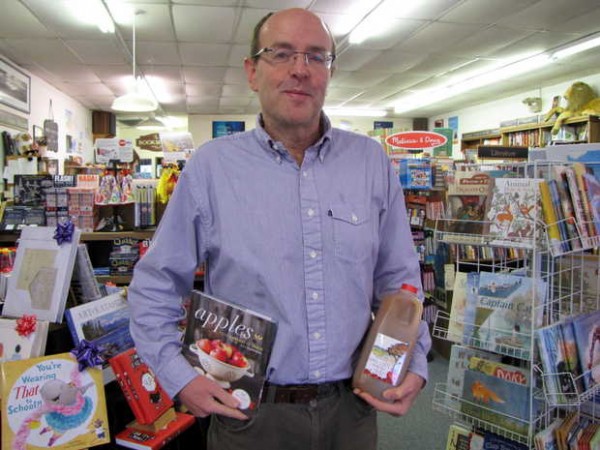 Ever since his first guest post for ShelfTalker five years ago, DDG Booksellers owner Kenny Brechner has brought his creative, funny, irrepressible spirit—not to mention his considerable intellect and insight—to this blog. (You can find a full linked list of Kenny’s previous posts below.)
Ever since his first guest post for ShelfTalker five years ago, DDG Booksellers owner Kenny Brechner has brought his creative, funny, irrepressible spirit—not to mention his considerable intellect and insight—to this blog. (You can find a full linked list of Kenny’s previous posts below.)
When Kenny stepped up several times this spring to contribute fabulous posts while your regular Shelftalker bloggers dealt with a family medical crisis, we decided it was high time to make his posts a regular treat for readers. It is with great glee that we announce Kenny as the newest official ShelfTalker blogger, providing one new post every week! Woot!!
Continue reading
Do Books Need to Make Noise?
Josie Leavitt - June 16, 2014
There are certain books that make booksellers go a little bonkers. Often these crazy-making books are the ones that come with sound chips.
Who thought “Oh, hey, reading’s a quiet activity that can be shared with a child on your lap, let’s make it less about time together and more about NOISE?” Sure, books with sound chips make it easier for children to enjoy without a parent around, but as technology gets better, the chips get louder and the batteries seem to last forever. I recently ordered two potty training books (one for boys and one for girls) and they came with a sound chip of applause – lots of lots of applause and whooping and hollering. These books were faced-out (seems like every toddler is being toilet-trained this month) and they got a lot of attention. Am I missing something here? Why would reading a book about potty training need an applause track? Unless the book is being read in the bathroom by the toddler then, really, why? And even then, why?
The problem with noisy books is, as the bookseller who has them knows, you can’t then complain about a child getting a full-on standing ovation for 15 minutes playing with the book. Of course kids like the novelty of noisy books, but their appeal wears thin after just a few minutes to adult ears. If the clapping and whooping it up of the potty book weren’t bad enough, the truck books with the incessant back-up beeping noise is enough to make you homicidal. There’s always the one page that gets played over and over again.
All books with sound chips come with the plastic tab in the back to prevent the chip from going off until the book is taken home. I swear that kids, even newborns, today are smart enough to have figured out that the tab needs to go before the joy of the book can be savored. It’s easy to get that tab out, but for some reason, it’s really hard to put it back in. Very clever. And some days there are little tabs everywhere in the store. And here’s the thing: parents don’t like noisy books because they can’t take the noise either. I’ve often had aunts and uncles not buy books with sound chips “…because my sister will kill me.” So, why do these books continue to get made?
Lastly, it’s one thing to have two seconds of a noise when a certain page gets turned, but to have a full 10 seconds of noise is practically unbearable. I know 10 doesn’t sound like a long time, but count to 10 right now. Do it again and now imagine a concert hall of applause. Repeat this until you’ve lost your mind.
Spoofy Brilliance + the Anti-Anti-YA Book List, Compiled
Elizabeth Bluemle - June 13, 2014
 Earlier this week, I posted a call to gather titles to counter one writer’s Slate article dismissing YA books as not suitably literary or complex reading for adults. Suggestions poured in, and I’m posting the list of books below.
Earlier this week, I posted a call to gather titles to counter one writer’s Slate article dismissing YA books as not suitably literary or complex reading for adults. Suggestions poured in, and I’m posting the list of books below.
First, however, I wanted to share the first bit of my favorite response to the Ruth Graham article. Titled “A Young Adult Author’s Fantastic Crusade to Defend Literature’s Most Maligned Genre,” it was posted on Nerve.com by YA writer Kathleen Hale, and it begins this way:
Last week, I read Ruth Graham’s article “Against YA.” In it, Graham contends that adults should be embarrassed to read YA novels. Instead, grownups should focus their attention on serious, “literary fiction” that grapples with “big ideas about time and space and science and love.”
As a YA writer myself, I was understandably offended. I’m not some schlocky trash-peddler. I’m a serious author, capable of far more than maudlin plot twists and clichéd dialogue. That’s why I decided to confront Graham in person.
I picked her up outside the graveyard before nightfall.
“I’ve been waiting for you,” she said, as we stepped into my father’s beat up Chevy. We were going 70 miles an hour, two girls with different colored hair.
“Why did you say that about YA?” I asked, as tears streamed down my face like rain.
“Because it’s true!” she hissed. And I saw in the moonlight that her anger made her beautiful. This was before the war, when the oceans still had water, and the moon was still visible in the sky.
Hale’s post continues, hilariously, in this vein. It is clever, spooftastic fun, but also a glorious, smart reply to the issues raised in Ruth Graham’s article.
And now for the Anti-Anti-YA Book List of complex, rewarding young adult reads no one should be ashamed of reading and enjoying. The aim was to include only realistic YA, but a few fantasy, alternative reality, and graphic novels sneaked in. Thanks to all of the ShelfTalker readers who contributed:
13 Reasons Why by Jay Asher
17 and Gone by Nova Ren Suma.
33 Snowfish by Adam Rapp
The Absolutely True Diary of a Part-Time Indian by Sherman Alexie
Afterparty by Ann Redisch Stampler
anything by Sarah Dessen
Aristotle and Dante Discover the Secrets of the Universe by Benjamin Alire Saenz
The Astonishing Life of Octavian Nothing, Traitor to the Nation: The Pox Party by M.T. Anderson
Beauty Queens by Libba Bray
Belle Epoque by Elizabeth Ross
Berlin Boxing Club by Robert Sharenow
Between Shades of Gray by Ruta Sepetys
Bitterblue by Kristin Cashore
Black Juice by Margo Lanagan
Bone Dance by Martha Brooks
The Book Thief by Markus Zusak
Breathe My Name by R.A. Nelson
Candy by Kevin Brooks
The Chocolate War by Robert Cormier
Code Name Verity by Elizabeth Wein
Confessions of a Hater by Caprice Crane
Crossing Stones by Helen Frost
The Curious Incident of the Dog in the Night-Time by Mark Haddon
Dark Dude by Oscar Hijuelos
Deerskin by Robin McKinley
The Diviners by Libba Bray
Downriver by Will Hobbs
Eleanor & Park by Rainbow Rowell
Every Day by David Levithan
Fangirl by Rainbow Rowell
Fat Angie by e.E. Charlton-Trujillo
Fighting Ruben Wolfe by Markus Zusak
Finninkin of the Rock by Melina Marchetta
For the Win by Cory Doctorow
Gil Marsh by A.C.E. Bauer
Going Bovine by Libba Bray
Graceling by Kristin Cashore
Grasshopper Jungle by Andrew Smith
Grave Mercy by R.L. LaFevers
Gringolandia by Lyn Miller-Lachmann
Guy in Real Life by Steve Brezenoff
Hard Love by Ellen Wittlinger
Heart’s Delight by Per Nilsson
how i live now by Meg Rosoff
How to Say Goodbye in Robot by Natalie Standiford
Hush by Eishes Chayil
I Am J by Cris Beam
I Am the Messenger by Markus Zusak
I’ll Be There by Holly Goldberg Sloan
If You Come Softly by Jacqueline Woodson
If You Could Be Mine by Sara Farizan.
The Impossible Knife of Memory by Laurie Halse Anderson
In Darkness by Nick Lake
Jellicoe Road by Melina Marchetta
Jumped by Rita Williams-Garcia
Kingdom of Little Wounds by Susann Cokal
The Kings Are Already Here by Garret Freymann-Weyr
The Knife of Never Letting Go (Chaos Walking trilogy) by Patrick Ness
Last Night I Sang to the Monster by Benjamin Alire Saenz
Lessons from a Dead Girl by Jo Knowles
Liar by Justine Larbalestier
Life as We Knew It (Mooncrash series) by Susan Beth Pfeffer
Life: An Exploded Diagram by Mal Peet
Like the Red Panda by Andrea Seigel
The List by Siobhan Vivian
Little Women by Louisa May Alcott
Looking for Alaska by John Green
Love is the Higher Law by David Levithan
Love Letters to the Dead by Ava Dellaria
Me and Earl and the Dying Girl by Jesse Andrews
Midwinterblood by Marcus Sedgwick
A Monster Calls by Patrick Ness
My Book of Life by Angel by Martine Leavitt
My Soon-to-be Sex Life by Judith Tewes
No Safe Place by Deborah Ellis
Once Was Lost by Sara Zarr
The Opposite of Hallelujah by Anna Jarzab
Paper Covers Rock by Jenny Hubbard
the perks of being a wallflower by stephen chbosky
Persepolis by Marjane Satrapi
The Piper’s Son by Melina Marchetta
Please Ignore Vera Dietz by A.S. King
Pointe by Brandy Colbert
Postcards from No Man’s Land by Aidan Chambers
Prisoner of Night and Fog by Anne Blankman
Revolver by Marcus Sedgwick
Rose Under Fire by Elizabeth Wein
The Scorpio Races by Maggie Stiefvater
Sean Griswold’s Head by Lindsey Leavitt
The Secret Side of Empty by Maria E. Andreu
Seraphina by Rachel Hartman
Served Anytime by Sarah Combs
Shine by Lauren Myracle
Since You Left Me by Allen Zadoff
Sister Mischief by Laura Goode
Skim by Mariko Tamaki (graphic novel)
Solace of the Road by Siobhan Dowd
Someday This Pain Will Be Useful to You by Peter Cameron
Sorta Like a Rockstar by Matthew Quick
Speak by Laurie Halse Anderson
Stick by Andrew Smith
Stoner and Spaz by Ron Koertge
The Strange and Beautiful Sorrows of Ava Lavender by Leslye Walton
Suckerpunch by David Hernandez
Tamar by Mal Peet
Taste of Salt by Frances Temple
Tender Morsels by Margo Lanagan
The Thief by Megan Whalen Turner
This is How I Find Her by Sara Polsky
Toning the Sweep by Angela Johnson
Two Boys Kissing by David Levithan
The Tyrant’s Daugher by J. C. Carleson
Under the Mesquite by Guadalupe Garcia McCall
We Were Liars by E. Lockhart
Whale Talk (and other novels) by Chris Crutcher
Where Things Come Back by John Corey Whaley
The White Darkness by Geraldine McCaughrean
Will Grayson, Will Grayson by John Green and David Levithan
Winger by Andrew Smith
With or Without You by Brian Farrey
Yaqui Delgado Wants to Kick Your Ass by Meg Medina
A Mysterious Sales Spike, Revealed
Elizabeth Bluemle - June 12, 2014
Recently, the store has had a run on copies of The School for Good and Evil. The book has been out for some time in hardcover (published May 2013), and sold very well here in our neck of the woods, above average in its genre but with a quieter level of customer demand than, say, Divergent or The Hunger Games.
The School for Good and Evil came out in paperback back in April, but the demand for it here ramped up exponentially this past week. Suddenly, it seemed, every 10-year-old in the county wanted that book.
I couldn’t figure out what had made the difference. Had a movie or TV show based on the book just come out and I’d missed it? Had the title shown up on a Scholastic order form in some particularly effective, attention-getting way? I wasn’t sure, but I knew to stick a stack of copies on the front counter. Sure enough, they flew out the door even faster.
What gave? Finally, I received my answer. A fifth-grade boy came in with his mom looking for a copy of My Side of the Mountain for a friend’s birthday, and he spotted The School for Good and Evil by the register. “That’s supposed to be really good,” he said to his mom. “Want to get it?” she asked. “Sure,” he said. (Booksellers love that conversation.) This boy was the tipping point for me; I had to know how he had become interested in this title that showed two female main characters on the cover. Even though I fiercely believe a good story is a good story, and avoid gender-stereotyping reader preferences, 10-year-old boys aren’t always in the habit of diving for books with girls on the cover. (Not my world; I just live in it.)
“Hey, Kyle,” I said. “This book is really popular with kids your age right now. How did you hear about it?” His was the simplest of answers, and as a retailer with 75-85% of sales attributable to direct recommendations to customers, I should have anticipated it: “Rainey did a book talk.” Rainey is a girl in his class; the fifth graders had been doing book recommendations in their language arts class, and Rainey’s presentation on The School for Good and Evil had made everyone in the room want to read it. Word of mouth spread, and soon the whole fifth grade was running to bookstores and libraries on a mission.
Then Kyle charmed the socks off me by asking earnestly, “Have kids also been asking for The Hunger Games? And the Percy Jackson books? And Spirit Animals?” It was clear those were the books he had recommended to his classmates, and I was pleased to be able to tell him that yes, they had.
And when he and Rainey turn 14, I hope they want summer jobs handselling books at my store.
Young Readers and Writers
Josie Leavitt - June 10, 2014
Every year for the past five, we’ve hosted a reading celebration that’s run through our local PBS station. This past Saturday seven young readers from all over northern Vermont dressed up in their fancy clothes to read their illustrated stories. I love this story time for many reasons, but the main one is the variety of stories and the absolute loveliness of the kids.
Children and their families started streaming in about 20 minutes before the reading. They found seats and then browsed nervously. The mix of pride and fear was evident in all the readers who were mostly third and fourth graders. Elizabeth hosted the event with grace and a calming style that helped soothe all the young writers. She and I discussed the order of the readings and told the kids we would start from the end of the alphabet. This made it real. Kids started squirming. One child blanched, realizing that instead of going near the end (her name began with a W) she would be going first.
One by one, they read their stories, about horses, a Lego man, siblings, and being scared by noises; some of them whispered, some shouted, but all were proud, and they should have been. These stories were good, they were full of great images, both drawn and written, and complex plot lines with dialogue and humor. These were young writers and I was glad to hear their stories and be part of their event. 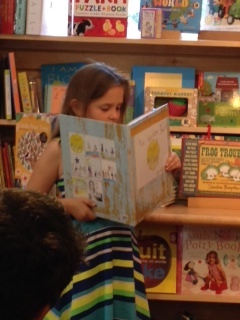
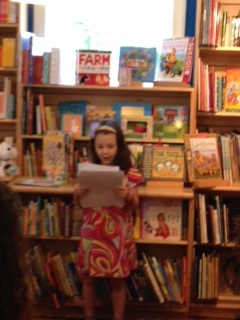
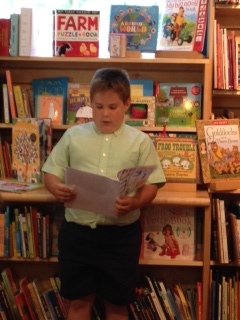
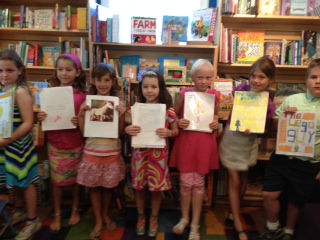
Getting Ready for Summer Reading
Josie Leavitt - June 9, 2014
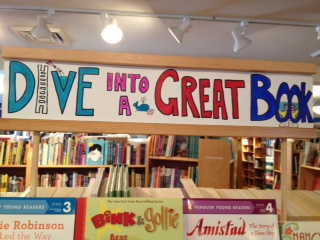 It’s that time of year again: time to stock up on summer reading. Kids and parents are starting to stream in looking for books for camp, stocking up on the required reading of summer, and some eager teens are just looking forward to reading for pleasure again. Every year we make it easy for them to find these by making a special cart of books, but this year, Elizabeth got really creative. Continue reading
It’s that time of year again: time to stock up on summer reading. Kids and parents are starting to stream in looking for books for camp, stocking up on the required reading of summer, and some eager teens are just looking forward to reading for pleasure again. Every year we make it easy for them to find these by making a special cart of books, but this year, Elizabeth got really creative. Continue reading
Let’s Compile the Anti-Anti-YA Reading List
Elizabeth Bluemle - June 6, 2014

Many of you will already have read Ruth Graham’s Slate.com article, Against YA, with its finger-wagging subtitle, “Read whatever you want. But you should feel embarrassed when what you’re reading was written for children.”
While Ms. Graham’s perspective is of course a limited view of the richness and complexity that can be found in literature for teens, it’s not too hard to guess where some of her anxieties come from: the sense that our culture is gradually infantilizing itself and that grownups are few and far between. I’m just not convinced that adults reading YA literature is a sign of the impending immaturity apocalypse.

“Against YA” reads like most media coverage of children’s and YA literature; that is, written by someone outside the field who reads one or two titles and draws conclusions that make those inside the field roll their eyes (Ms. Graham’s own “adult” response to some passages she has encountered in books for teens).Adult readers read YA books for all kinds of reasons – nostalgia and escape may be among those impulses, and there is no shame in that, but there is also so much more in great YA. Through books written for young people, we visit different worlds, we connect with teens and young adults, we challenge our own notions of what it means to be a young person in the world today. And we encounter some damn fine literature. (Octavian Nothing, anybody?)

I’m not sure what is gained by shaming anybody about reading. If Ms. Graham is concerned that adults will become so enamored of the escapist, tidy-ending, light YA fiction she disdains that they will stop reading adult literature, all she has to do is visit a bookstore and ask the clerks what they’ve observed. At the Flying Pig, at least, adults who read YA have not abandoned their Alice Munro and Flannery O’Connor, their Rohinton Mistry and Tolstoy; they’ve just added something new to the mix.
Many wonderful bloggers have already responded well and thoughtfully to Ms. Graham’s article. What I’d like to do is to gather a delicious list of complex, literarily rewarding YA titles (which must be realistic fiction, since that is the genre assessed and addressed in the article) that challenge the assumptions therein.
Here are some of Ms. Graham’s issues with YA literature as reading for adults:
1) “At its heart, YA aims to be pleasurable.There’s of course no shame in writing about teenagers; think Shakespeare or the Brontë sisters or Megan Abbott. But the very ways that YA is pleasurable are at odds with the way that adult fiction is pleasurable. [… Crucially, YA books present the teenage perspective in a fundamentally uncritical way.”

Wow. This last sentence is one of the most reductive lines in the article. Let’s get on that one posthaste. Come to think of it, though, doesn’t most adult literature present adult perspective in a fundamentally uncritical way? Readers don’t sit back and sneer, ‘What a grownup thing to think!” This us/them view of teenagers and adults is perhaps the aspect of the “Against YA” article that bothers me most. Yes, teenagers are younger, often less experienced humans, and adults are older, often more experienced humans. So what? We have all met teens who have astonished us with their wisdom and compassion, their insight and intelligence, their creativity and drive. And we have all met adults who … have not. But to get back to literature, let’s find those contemporary realistic YA books that present a rich, notuncritical, teen perspective. I’ll toss out Aidan Chambers’ Postcard from No Man’s Land for starters. And how about Hard Love by Ellen Wittlinger, a nuanced book with a non-tidy ending? Or We Were Liars by E. Lockhart?
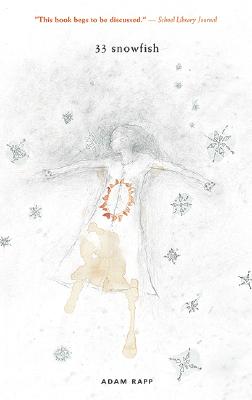 2) Even “the myriad defenders of YA fiction admit that the enjoyment of reading this stuff has to do with escapism, instant gratification, and nostalgia. […I]f people are reading Eleanor & Park instead of watching Nashville or reading detective novels, so be it, I suppose. But if they are substituting maudlin teen dramas for the complexity of great adult literature, then they are missing something.”
2) Even “the myriad defenders of YA fiction admit that the enjoyment of reading this stuff has to do with escapism, instant gratification, and nostalgia. […I]f people are reading Eleanor & Park instead of watching Nashville or reading detective novels, so be it, I suppose. But if they are substituting maudlin teen dramas for the complexity of great adult literature, then they are missing something.”
Well, who could argue with a false dichotomy like that? Maudlin teen dramas vs. complex adult literature. How about we find some complex teen literature? How about Adam Rapp’s harrowing and brilliant, unforgettable and undeniably YA 33 Snowfish?
Readers, what YA realistic fiction titles — that you think reward adult readers as richly as teens — would you like to add to the anti-anti-YA reading list?
Berry Season
Josie Leavitt - June 5, 2014
It’s finally starting to feel like summer here in Vermont and with that comes the increase in requests for books about berries. There is nothing quite like the fresh berries of summer. In my area there are a plethora of pick-your-own berry farms that make a summer outing all the more enjoyable. It’s easy to forget that kids are still learning about food and the seasonal availability of fresh, local berries. The joy of berries is they are good for you and most children love them.
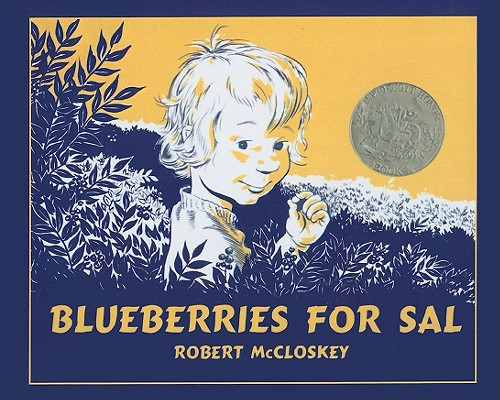 Of course, Blueberries for Sal is probably my most favorite book about berries. In a humorous mix-up, Little Sal and Little Bear almost switch moms in the quest for blueberries. This classic book really captures the joy of picking berries and the sounds the berries landing in the metal pail with the now famous: Kuplink, kuplank, kuplunk. I think at some point all of us who have gone blueberry picking have wound up eating our fair share of berries as well.
Of course, Blueberries for Sal is probably my most favorite book about berries. In a humorous mix-up, Little Sal and Little Bear almost switch moms in the quest for blueberries. This classic book really captures the joy of picking berries and the sounds the berries landing in the metal pail with the now famous: Kuplink, kuplank, kuplunk. I think at some point all of us who have gone blueberry picking have wound up eating our fair share of berries as well.
Continuing the theme of bears and berries, Jamberry is another book about the fantastical joys of 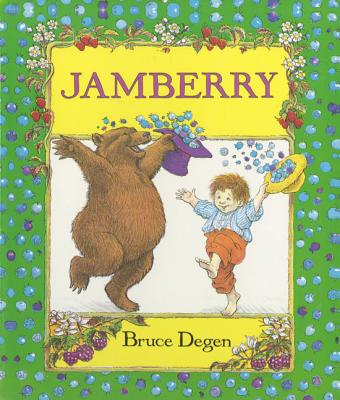 berry picking in a magical land. Exuberant rhyme make this berry-hunting book a delight and will get kids ready for all manner of berry that might come their way.
berry picking in a magical land. Exuberant rhyme make this berry-hunting book a delight and will get kids ready for all manner of berry that might come their way.
One of the best storytime books is The Little Mouse, the Red-Ripe Strawberry and the Big Hungry Bear, about a mouse and bear who both love berries. (I think bears are in peril of being maligned in all these berry books.) The illustrations in this book are lovely and the message about sharing is nicely 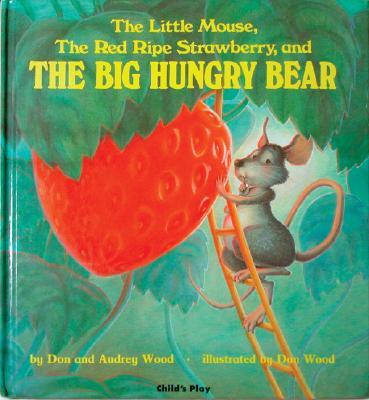 handled. The mouse wants to save his freshly picked strawberry from the bear, and the only way he can do that is to share it with the reader.
handled. The mouse wants to save his freshly picked strawberry from the bear, and the only way he can do that is to share it with the reader.
What happens once you pick all these glorious berries? You 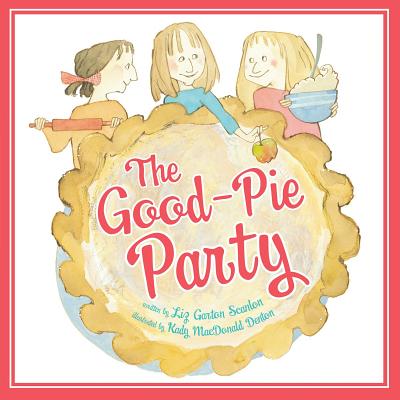 make a pie, of course. There’s a new book out this season,The Good-Pie Party, which turns the sadness of a girl moving into a celebration of friendship and the joy of sharing pie. There’s also the older book, The Blueberry Pie Elf, about an blueberry-loving little elf with a large appetite for pie.
make a pie, of course. There’s a new book out this season,The Good-Pie Party, which turns the sadness of a girl moving into a celebration of friendship and the joy of sharing pie. There’s also the older book, The Blueberry Pie Elf, about an blueberry-loving little elf with a large appetite for pie.
What are some of your favorite books about the bounty of summer berries?
World Premiere: Two Tunes for Authors (and Editors)
Elizabeth Bluemle - June 3, 2014
Every year, my literary agent, Erin Murphy, and her crack team of co-agents and office gurus put together a retreat for their clients. The retreat moves around the country from one region to the next, and this year, it was held in Vermont. Sixty-seven talented, funny, crazy children’s book writers and illustrators descended on my unsuspecting state, pretty much doubling our population.
And why on earth might this interest you, dear Reader? Well, because among those authors and illustrators are eight musical souls who have banded together, literally, to reveal the inner workings of an author’s brain. (Psst: It’s scary in there.) The band is called Erin Murphy’s Dog, and their motto is “In bocca al coniglio,” a faux-mild children’s-book-worthy appropriation of the galvanizing Italian phrase “in boca al lupo” (literally, “in the mouth of the wolf,” but it means “break a leg!”).
The members of the band are (l. to r. front row) Carrie Gordon Watson, Deborah Underwood, (l. to r. back row) Kristin Nitz, Jeannie Mobley, Mike Jung, Arthur A. Levine (yes, that Arthur A. Levine), Ruth McNally Barshaw, and Conrad Wesselhoeft.
The band performed to a wildly appreciative crowd of agency mates, and two of the songs were particularly amusing for anyone involved in the children’s literature field. So it is my great pleasure to announce the world premiere of “Editorial Delay” and “YA Cha-Cha Blues.”
Not only are the songs clever and funny, they offer other gifts. In the words of band member Mike Jung, “These songs have it all – intensely complicated ukulele chords, 12-bar blues wizardry, freewheeling choreography, author/editor humor, and a broad variety of Muppet-like facial expressions. Also, a lot of love, because I love these people with all my heart. IN BOCCA AL CONIGLIO!”
Big thanks to Erin Murphy’s Dog for permission to post these videos, with extra gratitude to agency mate, e.E. Charlton-Trujillo, who did the three-camera video recording of these songs and synced the sound and color-corrected on the fly to meet this ShelfTalker deadline!
Erin Murphy’s Dog Performs “Editorial Delay” (music by Deborah Underwood, words by Deborah Underwood and Arthur A. Levine) from e.E. Charlton-Trujillo on Vimeo.
Erin Murphy’s Dog – YA Cha-Cha Blues (words and music by Conrad Wesselhoeft, in response to a conversation he had with agent and super knitter Erin Murphy about how the writing life can be back and forth … and back and forth) from e.E. Charlton-Trujillo on Vimeo.
Bravo! Bravo!
Adoring fans are welcome to leave comments (but not flowers or flung underwear) below. As Erin Murphy’s Dog would say, “Arrroooo!”


